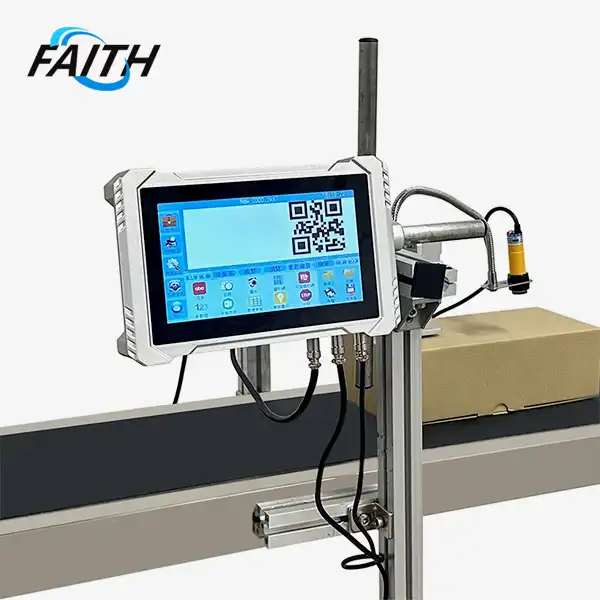Fixing Common Issues with Large Character Marking Printers
Large Character Marking (LCM) Printers are indispensable tools in various industries for marking and coding products with clear, legible characters. However, like any sophisticated machinery, these printers can encounter issues that affect their performance. This comprehensive guide will explore common problems faced by LCM printer users and provide practical solutions to keep your printing operations running smoothly. By addressing these issues promptly, you can maintain optimal print quality, reduce downtime, and extend the lifespan of your LCM printer.
Understanding LCM Printer Technology and Its Challenges
Large Character Marking Printers are designed to produce high-quality, large-format prints on various surfaces. These printers utilize advanced technology to create clear, durable markings that withstand harsh industrial environments. However, the complexity of LCM printers can lead to several challenges that users must navigate.
The Mechanics of LCM Printing
LCM printers typically use piezoelectric or thermal inkjet technology to produce large, bold characters. The printing process involves precise control of ink droplets, which are ejected through nozzles onto the target surface. This technology allows for versatile printing on various materials, including porous and non-porous surfaces.
Common Challenges in LCM Printing
Despite their robustness, LCM printers can face issues such as clogged nozzles, ink flow problems, and print quality inconsistencies. These challenges often stem from factors like ink properties, environmental conditions, and faith printer maintenance practices. Understanding these potential pitfalls is crucial for effective troubleshooting and prevention.
The Impact of Print Quality on Operations
Maintaining high print quality is paramount in industries relying on Large Character Marking (LCM) Printers. Poor print quality can lead to illegible product codes, batch numbers, or expiration dates, potentially resulting in regulatory non-compliance, product recalls, or customer dissatisfaction. Therefore, addressing print quality issues promptly is essential for maintaining operational efficiency and product integrity.
Troubleshooting Print Quality Issues in LCM Printers
Print quality problems are among the most common issues faced by LCM printer users. These issues can manifest in various ways, from faint or incomplete prints to smudged or distorted characters. Addressing these problems requires a systematic approach and an understanding of the underlying causes.
Identifying Print Quality Problems
The first step in troubleshooting print quality issues is to accurately identify the problem. Common print quality issues include:
- Faint or light prints
- Missing characters or incomplete prints
- Blurry or smudged prints
- Inconsistent print density
- Misaligned or skewed characters
Each of these issues can have multiple causes, ranging from simple ink flow problems to more complex mechanical or electronic issues.
Resolving Ink-Related Issues
Many prints quality problems stem from ink-related issues. To address these:
- Check ink levels and refill if necessary
- Ensure ink cartridges are properly seated and secured
- Verify that the correct ink type is being used for your specific printer model
- Clean ink nozzles and printheads to remove clogs or dried ink
- Replace ink filters if present in your LCM printer model
Regular maintenance of the ink system can prevent many common print quality issues before they occur.
Adjusting Printer Settings for Optimal Performance
Sometimes, print quality issues can be resolved by fine-tuning printer settings. Consider the following adjustments:
- Calibrate print density settings to match the substrate material
- Adjust print speed to ensure proper ink drying and adhesion
- Verify and adjust printhead-to-substrate distance for optimal print clarity
- Check and adjust print direction settings for consistent character formation
Many modern LCM printers, like those featuring a 16-point touch screen with large characters, offer user-friendly interfaces for easy adjustment of these settings.
Maintaining and Optimizing LCM Printer Performance
Regular maintenance and optimization are key to ensuring consistent performance and longevity of your LCM printer. By implementing a proactive maintenance routine, you can prevent many common issues and keep your printer operating at peak efficiency.
Establishing a Maintenance Schedule
Create a comprehensive maintenance schedule that includes:
- Daily cleaning of printheads and nozzles
- Weekly inspection of ink delivery systems
- Monthly check of all mechanical components
- Quarterly deep cleaning and calibration
Adhering to a regular maintenance schedule can significantly reduce the likelihood of unexpected printer failures and extend the life of your equipment.
Optimizing Environmental Conditions
The environment in which your large character inkjet printer operates can significantly impact its performance. Consider the following factors:
- Maintain consistent temperature and humidity levels in the printing area
- Protect the printer from dust, debris, and other contaminants
- Ensure proper ventilation to prevent overheating
- Use anti-static measures in environments prone to static electricity
By optimizing environmental conditions, you can improve print quality and reduce the risk of printer malfunctions.
Upgrading and Updating LCM Printer Systems
Staying current with printer technology can help prevent issues and improve overall performance. Consider the following upgrade options:
- Install the latest firmware updates for your LCM printer
- Upgrade to newer, more efficient ink cartridge systems
- Consider replacing older printers with newer models that offer improved features and reliability
Modern LCM printers, such as those with 4.3-inch LCD touch screens and upgraded nozzle and valve body designs, offer enhanced clarity, stability, and ease of use compared to older models.
Training and Empowering Operators
Well-trained operators are crucial for maintaining optimal Large Character Marking (LCM) Printer performance. Implement comprehensive training programs that cover:
- Proper printer operation and setting adjustments
- Basic troubleshooting techniques
- Routine maintenance procedures
- Identifying and reporting more complex issues
By empowering operators with knowledge and skills, you can ensure quick resolution of minor issues and proper escalation of more significant problems.
FAQ
Q: How often should I clean my LCM printer's printheads?
A: It's recommended to clean printheads daily or at the start of each production shift to maintain optimal print quality.
Q: Can environmental factors affect my LCM printer's performance?
A: Yes, factors like temperature, humidity, and dust can significantly impact printer performance. Maintain a controlled environment for best results.
Q: What should I do if my prints are consistently faint or incomplete?
A: Check ink levels, clean printheads, and verify printer settings. If issues persist, consult your printer's manual or contact technical support.
Conclusion
Effectively addressing common issues with Large Character Marking (LCM) Printers is crucial for maintaining efficient and reliable marking operations. By understanding the mechanics of LCM printing, implementing regular maintenance routines, and staying proactive in troubleshooting, you can significantly reduce downtime and improve print quality. Remember that modern LCM printers offer advanced features like touch screen interfaces and improved nozzle designs that can enhance your printing capabilities and ease of use.
For more information on industrial UV inkjet coding and traceability system solutions, including state-of-the-art LCM printers, please contact us at sale01@sy-faith.com. Our team of experts is ready to help you optimize your marking and coding processes with cutting-edge technology and comprehensive support.
References
1. Johnson, M. (2022). Advanced Techniques in Large Character Marking for Industrial Applications. Journal of Industrial Printing Technology, 15(3), 78-92.
2. Smith, R., & Brown, T. (2021). Troubleshooting Guide for Industrial Inkjet Printers. Industrial Printing Solutions Press.
3. Lee, S. (2023). Environmental Factors Affecting Large Character Marking Performance. International Journal of Printing Science, 8(2), 145-160.
4. Garcia, A., & Wilson, P. (2022). Optimizing Maintenance Schedules for LCM Printers in High-Volume Production Environments. Manufacturing Technology Quarterly, 37(4), 210-225.
5. Thompson, E. (2023). The Future of Large Character Marking: Trends and Innovations. Industrial Coding and Marking Review, 12(1), 18-33.
Online Message
Learn about our latest products and discounts through SMS or email
_1754985850591.jpg)


